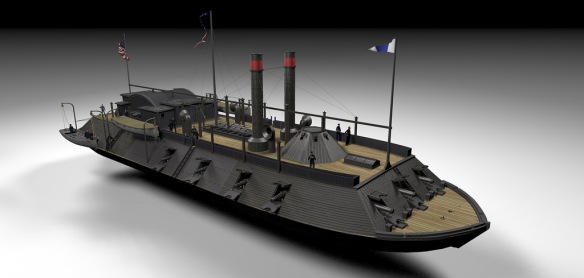At the beginning of the war, the army and navy were mostly employed in protecting the loyal people who resided on the borders of the disaffected states and in reconciling those whose sympathies were opposed. But the defeat at Manassas and other reverses convinced the Government of the serious nature of the contest, and of the necessity of more vigorous and extensive preparations for war.
Our navy yards were soon filled with workmen; recruiting stations for unemployed seamen were established, and we soon had more sailors than were required for the ships that could be fitted for service. Artillerymen for the defences of Washington being scarce, five hundred of these sailors, with a battalion of marines (for guard duty), were sent to occupy the forts on Shuter’s Hill, near Alexandria. The Pensacola and the Potomac flotilla and the seaboard navy yards required nearly all of the remaining unemployed seamen.
While Foote was improvising a flotilla for the western rivers he was making urgent appeals to the government for seamen. Finally someone at the Navy Department thought of the five hundred tars stranded on Shuter’s Hill. And obtained an order for their transfer to Cairo, where they were placed on the receiving ship Maria Denning. There they met fresh-water sailors from our great lakes, and steam-boat hands from the Western rivers. Of the seamen from the East, there were Maine lumbermen, New Bedford whalers, New York liners, and Philadelphia sea-lawyers. The foreigners enlisted were mostly Irish, with a few English and Scotch, French, Germans, Swedes, Norwegians, and Danes. The Northmen, considered the hardiest race in the world, melted away in the Southern sun with surprising rapidity.
On the gun-boat Carondelet were more young men perhaps than on any other vessel in the fleet. Philadelphians were in the majority; Bostonians came next, with a sprinkling from other cities, and just enough men-o’-war’s men to leaven the lump with naval discipline. The St. Louis had more than its share of men-o’-war’s men, Lieutenant-Commander Paulding having had the first choice of a full crew, and having secured all the frigate Sabine’s reenlisted men who had been sent West.
During the spring and summer of 1861, Commanders Rodgers, Stemble, Phelps, and Mr. James B. Eads had purchased, equipped, and manned, for immediate service on the Ohio and Mississippi rivers, three wooden gunboats — the Taylor, of six eight-inch shell guns and one thirty-two pounder; the Lexington, of four eight-inch shell-guns and one thirty-two pounder, and the Conestoga, of three thirty-two pounder guns. This nucleus of the Mississippi flotilla (like the fleets of Perry, Macdonough, and Chauncey in the war of 1812) was completed with great skill and dispatch; they soon had full possession of the Western rivers above Columbus, Kentucky, and rendered more important service than as many regiments could have done. On October 12, 1861, the first of the seven iron-clad gunboats ordered of Mr. Eads by the Government was launched at Carondelet, near St. Louis. She was named the St. Louis by Admiral Foote; but there being another vessel of that name in the navy, she was afterward called the De Kalb. The other ironclads, the Cincinnati, Carondelet, Louisville, Mound City, Cairo, and Pittsburgh, were launched soon after the St. Louis. Mr. Eads having pushed forward the work with most commendable zeal and energy. Two of these were built at Mound City, III. To the fleet of iron-clads above named were added the Benton (the largest and best vessel of the Western flotilla), the Essex, and a few smaller and partly armored gun-boats.
Flag-Officer Foote arrived at St. Louis on September 6th, and assumed command of the Western flotilla. He had been my fellow midshipman in 1827, on board the United States ship Natchez, of the West India squadron, and was then a promising young officer. At Pensacola, in the fall of 1828, the ship was visited with yellow fever; and we had to go ashore and encamp on Santa Rosa Island, clean out and disinfect the ship, and sail to New York to escape the pestilence. From the Natchez Foote was transferred to the Hornet, of the same squadron, and was appointed her sailing-master. After he left the Natchez, we never met again until February, 1861, at the Brooklyn Navy Yard, where he was the executive officer. Foote, Schenck, and myself were then the only survivors of the midshipmen of the Natchez, in her cruise of 1827, and now I am the only officer left.
During the cruise of 1827, while pacing the deck at night, on the lonely seas, and talking with a pious shipmate, Foote became convinced of the truth of the Christian religion, of which he was an earnest professor to the last. He rendered important service while in command of the brig Perry, on the coast of Africa, in 1849, in suppressing the slave trade, and he greatly distinguished himself by his skill and gallantry in the attack upon the Barrier Forts, near Canton (1856), which he breached and carried by assault, leading the assailing column in person. He was slow and cautious in arriving at conclusions, but firm and tenacious of purpose. He has been called “the Stonewall Jackson of the Navy.” He often preached to his crew on Sundays, and was always desirous of doing good. He was not a man of striking personal appearance, but there was a sailor-like heartiness and frankness about him that made his company very desirable.
Flag-Officer Foote arrived at Cairo September 12th, and relieved Commander John Rodgers of the command of the station. The first operations of the Western flotilla consisted chiefly of reconnaissances on the Mississippi, Ohio, Cumberland, and Tennessee rivers. At this time it was under the control of the War Department, and acting in cooperation with the army under General Grant, whose headquarters were at Cairo.
By Admiral Henry Walke
